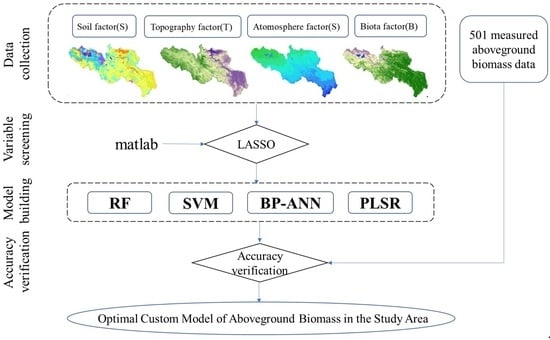Spatio-Temporal Variation Characteristics of Aboveground Biomass in the Headwater of the Yellow River Based on Machine Learning
Abstract
:1. Introduction
2. Materials and Methods
2.1. Study Area
2.2. Data Source and Preprocessing
2.2.1. AGB Data Source
2.2.2. Environmental Variable Data Source
2.3. Methods and Modelling
2.3.1. Variable Selection
2.3.2. Modeling Methods
2.3.3. Model Accuracy Evaluation
2.3.4. Trend Analysis
3. Results
3.1. Analysis of Model Results
3.1.1. Correlation Analysis between AGB and Environmental Variables
3.1.2. Correlation Analysis between AGB and Environmental Variables
3.1.3. Model Accuracy Evaluation
3.2. Spatial and Temporal Dynamic Distribution of AGB
3.3. Trend Analysis of AGB Changes
4. Discussion
4.1. Compared with Traditional Univariate Model
4.2. Reasons for AGB Changes
4.3. Advantages and Limitations of Custom Models
5. Conclusions
Author Contributions
Funding
Institutional Review Board Statement
Informed Consent Statement
Data Availability Statement
Acknowledgments
Conflicts of Interest
Appendix A

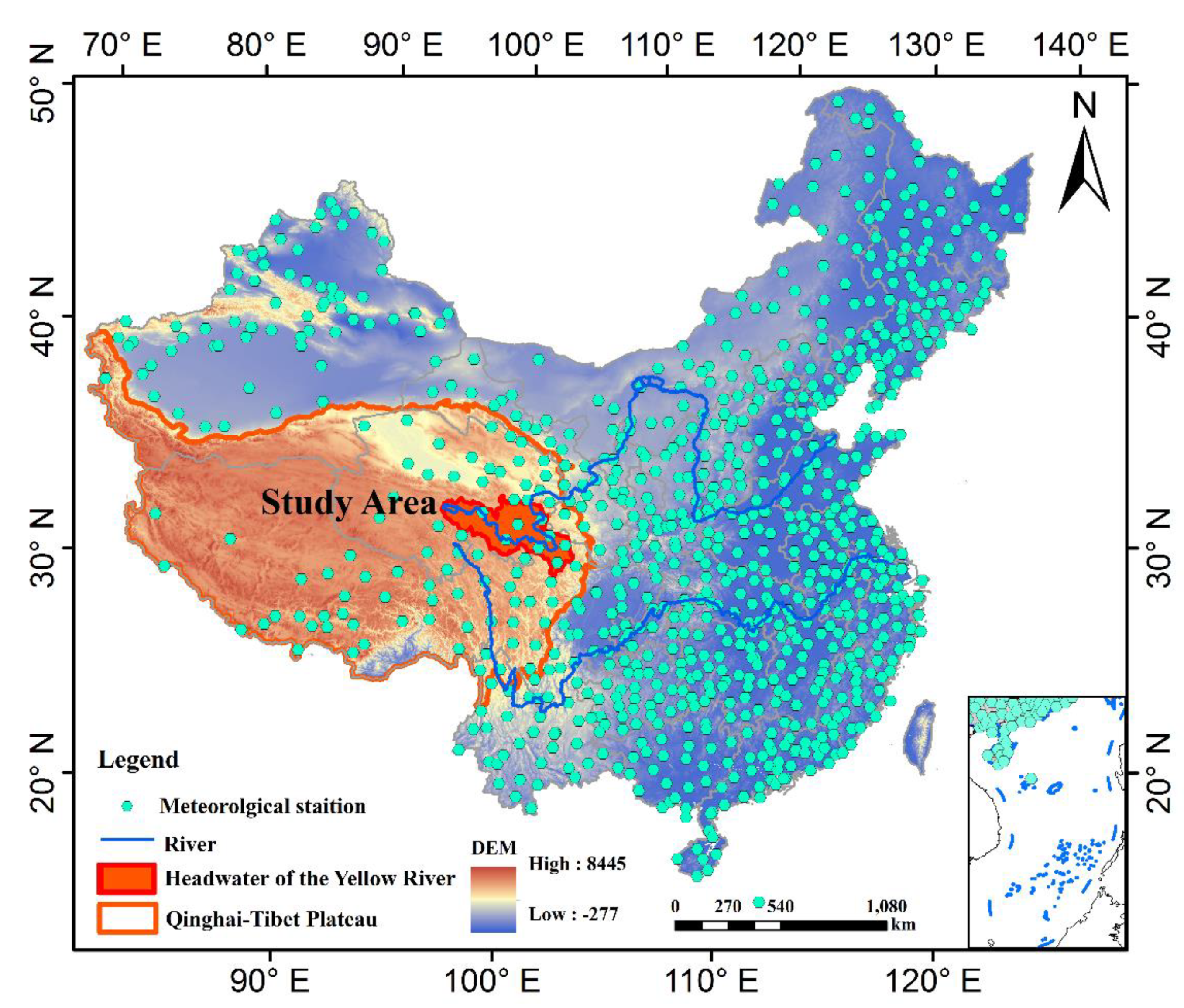
References
- White, R.P.; Murray, S.; Rohweder, M.; White, R.P.; Murray, S.; Rohweder, M. Pilot analysis of global ecosystems: Grassland ecosystems. World Resour. Inst. 2000, 4, 275. [Google Scholar]
- Curlock, J.M.O.S.; Hall, D.O. The global carbon sink: A grassland perspective. Glob. Chang. Biol. 2010, 4, 229–233. [Google Scholar] [CrossRef] [Green Version]
- Gao, X.X.; Dong, S.K.; Li, S.; Xu, Y.D.; Liu, S.L.; Zhao, H.D.; Yeomans, J.; Li, Y.; Shen, H.; Wu, S.N.; et al. Using the random forest model and validated MODIS with the field spectrometer measurement promote the accuracy of estimating aboveground biomass and coverage of alpine grasslands on the Qinghai-Tibetan Plateau. Ecol. Indic. 2020, 112, 106114. [Google Scholar] [CrossRef]
- Zeng, N.; Ren, X.; He, H.; Zhang, L.; Zhao, D.; Ge, R.; Li, P.; Niu, Z. Estimating grassland aboveground biomass on the Tibetan Plateau using a random forest algorithm. Ecol. Indic. 2019, 102, 479–487. [Google Scholar] [CrossRef]
- Zhou, W.; Li, H.R.; Xie, L.; Nie, X.; Wang, Z.; Du, Z.; Yue, T. Remote sensing inversion of grassland aboveground biomass based on high accuracy surface modeling. Ecol. Indic. 2021, 121, 107215. [Google Scholar] [CrossRef]
- Zhang, J.; Zhang, L.; Liu, W.; Qi, Y.; Wo, X. Livestock-carrying capacity and overgrazing status of alpine grassland in the Three-River Headwaters region, China. J. Geogr. Sci. 2014, 24, 303–312. [Google Scholar] [CrossRef]
- Xu, B.; Yang, X.C.; Tao, W.G.; Qin, Z.H.; Liu, H.Q.; Miao, J.M. MODIS-based remote sensing monitoring of grass production in China. Int. J. Remote Sens. 2008, 29, 5313–5327. [Google Scholar] [CrossRef]
- Diallo, O.; Ddiouf, A.; Hanan, N.P.; Ndiaye, A.; Prevost, Y. AVHRR monitoring of savanna primary production in Senegal, West Africa: 1987–1988. Int. J. Remote Sens. 1991, 12, 1259–1279. [Google Scholar] [CrossRef]
- Nouri, H.; Anderson, S.; Sutton, P.; Beecham, S.; Nagler, P.; Jarchow, C.J.; Roberts, D.A. NDVI, scale invariance and the modifiable areal unit problem: An assessment of vegetation in the Adelaide Parklands. Sci. Total Environ. 2017, 584–585, 11–18. [Google Scholar] [CrossRef]
- Paruelo, J.M.; Epstein, H.E.; Lauenroth, W.K.; Burke, I.C. ANPP estimates from NDVI for the central grassland region of the US. Ecology 1997, 78, 953–958. [Google Scholar] [CrossRef]
- Idowu, S.; Saguna, S.; Ahlund, C.; Schelen, O. Applied Machine Learning: Forecasting Heat Load in District Heating System. Energy Build. 2016, 133, 478–488. [Google Scholar] [CrossRef]
- Wang, Y.; Wu, G.; Lei, D.; Tang, Z.; Shangguan, Z. Prediction of aboveground grassland biomass on the Loess Plateau, China, using a random forest algorithm. Sci. Rep. 2017, 7, 6940. [Google Scholar] [CrossRef] [Green Version]
- Xie, Y.; Sha, Z.; Yu, M.; Bai, Y.; Zhang, L. A comparison of two models with Landsat data for estimating above ground grassland biomass in Inner Mongolia, China. Ecol. Model. 2009, 220, 1810–1818. [Google Scholar] [CrossRef]
- Yang, S.X.; Feng, Q.S.; Liang, T.G.; Liu, B.; Zhang, W.; Xie, H. Modeling grassland above-ground biomass based on artificial neural network and remote sensing in the Three-River Headwaters Region. Remote Sens. Environ. 2017, 204, 448–455. [Google Scholar] [CrossRef]
- Chu, H.; Wei, J.; Li, T.; Jia, K. Application of Support Vector Regression for Mid- and Long-term Runoff Forecasting in “Yellow River Headwater” Region. Procedia Eng. 2016, 154, 1251–1257. [Google Scholar] [CrossRef] [Green Version]
- Yang, L.; Li, X.; Shi, J.; Shen, F.; Zhou, C.J.G. Evaluation of conditioned Latin hypercube sampling for soil mapping based on a machine learning method. Geoderma 2020, 369, 114337. [Google Scholar] [CrossRef]
- Luo, D.; Jin, H.; Bense, V.F.; Jin, X.; Li, X. Hydrothermal processes of near-surface warm permafrost in response to strong precipitation events in the Headwater Area of the Yellow River, Tibetan Plateau. Geoderma 2020, 376, 114531. [Google Scholar] [CrossRef]
- Ma, T.; Brus, D.J.; Zhu, A.X.; Zhang, L.; Scholten, T.J.G. Comparison of conditioned Latin hypercube and feature space coverage sampling for predicting soil classes using simulation from soil maps. Geoderma 2020, 370, 114366. [Google Scholar] [CrossRef]
- McBratney, M. A conditioned Latin hypercube method for sampling in the presence of ancillary information. Comput. Geosci. 2006, 32, 1378–1388. [Google Scholar]
- Wang, C.; Lin, H.L.; Zhao, Y.T. A Modification of CIM for Prediction of Net Primary Productivity of the Three-River Headwaters, China. Rangel. Ecol. Manag. 2019, 72, 327–335. [Google Scholar] [CrossRef]
- Zhu, W.Q.; Pan, Y.Z.; Zhang, J.S. Estimation of Net Primary Productivity of Chinese Terrestrial Vegetation Based on Remote Sensing. J. Plant Ecol. 2007, 31, 413–424. [Google Scholar]
- Niharika, G. Introduction to the LASSO. Resonance 2018, 23, 439–464. [Google Scholar]
- Li, D.; Chen, Y. Computer and Computing Technologies in Agriculture V. Comput. Comput. Technol. Agric. 2016, 295, 104–112. [Google Scholar]
- Yang, X.; Liu, G.; He, J.; Kang, N.; Yuan, R.; Fan, N. Determination of sugar content in Lingwu jujube by NIR–hyperspectral imaging. J. Food Sci. 2021, 86, 1201–1214. [Google Scholar] [CrossRef] [PubMed]
- Ge, J.; Meng, B.P.; Liang, T.G.; Feng, Q.S.; Gao, J.L.; Yang, S.X.; Huang, X.D.; Xie, H. Modeling alpine grassland cover based on MODIS data and support vector machine regression in the headwater region of the Huanghe River, China. Remote Sens. Environ. 2018, 218, 162–173. [Google Scholar] [CrossRef]
- Gao, J.; Meng, B.; Liang, T.; Feng, Q.; Ge, J.; Yin, J.; Wu, C.; Cui, X.; Hou, M.; Liu, J.J.; et al. Modeling alpine grassland forage phosphorus based on hyperspectral remote sensing and a multi-factor machine learning algorithm in the east of Tibetan Plateau, China. ISPRS J. Photogramm. Remote Sens. 2019, 147, 104–117. [Google Scholar] [CrossRef]
- Xin, L.; Li, X.B.; Gong, J.R.; Li, S.K.; Wang, H.S.; Dang, D.L.; Xuan, X.J.; Wang, H. Remote-sensing inversion method for aboveground biomass of typical steppe in Inner Mongolia, China. Ecol. Indic. 2020, 120, 106683. [Google Scholar]
- Breiman, L. Random Forests. Mach. Learn. 2001, 45, 5–32. [Google Scholar] [CrossRef] [Green Version]
- Li, W.; Zhou, X.; Zhu, X.; Dong, Z.; Guo, W. Estimation of biomass in wheat using random forest regression algorithm and remote sensing data. Crop J. 2016, 3, 62–69. [Google Scholar]
- Ullah, S.; You, Q.; Ali, A.; Ullah, W.; Xie, X. Observed changes in maximum and minimum temperatures over China- Pakistan economic corridor during 1980–2016. Atmos. Res. 2019, 216, 37–51. [Google Scholar] [CrossRef]
- Wang, Y.; Huang, X.; Hui, L.; Sun, Y.; Feng, Q.; Liang, T.J. Tracking Snow Variations in the Northern Hemisphere Using Multi-Source Remote Sensing Data (2000–2015). Remote Sens. 2018, 10, 136. [Google Scholar] [CrossRef] [Green Version]
- Yin, S.; Guo, M.; Wang, X.; Yamamoto, H.; Ou, W. Spatiotemporal variation and distribution characteristics of crop residue burning in China from 2001 to 2018. Environ. Pollut. 2020, 268, 115849. [Google Scholar] [CrossRef] [PubMed]
- Ao, Y.; Li, H.Q.; Zhu, L.P.; Ali, S.; Yang, Z.G. The linear random forest algorithm and its advantages in machine learning assisted logging regression modeling. J. Pet. Sci. Eng. 2019, 174, 776–789. [Google Scholar] [CrossRef]
- Vincenzi, S.; Zucchetta, M.; Franzoi, P.; Pellizzato, M.; Pranovi, F.; De Leo, G.A.; Torricelli, P. Application of a Random Forest algorithm to predict spatial distribution of the potential yield of Ruditapes philippinarum in the Venice lagoon, Italy. Ecol. Model. 2011, 222, 1471–1478. [Google Scholar] [CrossRef]
- Yang, Z.P.; Gao, J.X.; Zhou, C.P.; Shi, P.L.; Zhao, L.; Shen, W.S.; Ouyang, H. Spatio-temporal changes of NDVI and its relation with climatic variables in the source regions of the Yangtze and Yellow rivers. J. Geogr. Sci. 2011, 21, 979–993. [Google Scholar] [CrossRef]
- Guo, B.; Zang, W.Q.; Yang, F.; Han, B.M.; Chen, S.T.; Liu, Y.; Yang, X.; He, T.L.; Chen, X.; Liu, C.T.; et al. Spatial and temporal change patterns of net primary productivity and its response to climate change in the Qinghai-Tibet Plateau of China from 2000 to 2015. J. Arid Land 2020, 12, 1–17. [Google Scholar] [CrossRef] [Green Version]
- Xiong, Q.L.; Xiao, Y.; Halmy, M.W.A.; Dakhil, M.A.; Liang, P.H.; Liu, C.G.; Zhang, L.; Pandey, B.; Pan, K.W.; El Kafraway, S.B.; et al. Monitoring the impact of climate change and human activities on grassland vegetation dynamics in the northeastern Qinghai-Tibet Plateau of China during 2000–2015. J. Arid Land 2019, 11, 637–651. [Google Scholar] [CrossRef] [Green Version]
- Tian, H.; Lan, Y.C.; Wen, J.; Jin, H.J.; Wang, C.H.; Wang, X.; Kang, Y. Evidence for a recent warming and wetting in the source area of the Yellow River (SAYR) and its hydrological impacts. J. Geogr. Sci. 2015, 25, 643–668. [Google Scholar] [CrossRef]
- Cai, H.Y.; Yang, X.H.; Xu, X.L. Human-induced grassland degradation/restoration in the central Tibetan Plateau: The effects of ecological protection and restoration projects. Ecol. Eng. J. Ecotechnol. 2015, 83, 112–119. [Google Scholar] [CrossRef]
- Liu, Y.Y.; Wang, Q.; Zhang, Z.Y.; Tong, L.J.; Wang, Z.Q.; Li, J.L. Grassland dynamics in responses to climate variation and human activities in China from 2000 to 2013. Sci. Total Environ. 2019, 690, 27–39. [Google Scholar] [CrossRef]
- Yang, Y.; Wang, Z.Q.; Li, J.L.; Gang, C.C.; Zhang, Y.Z.; Zhang, Y.; Odeh, I.; Qi, J.G. Comparative assessment of grassland degradation dynamics in response to climate variation and human activities in China, Mongolia, Pakistan and Uzbekistan from 2000 to 2013. J. Arid Environ. 2016, 135, 164–172. [Google Scholar] [CrossRef]
- Wu, Y.; Wu, T.M.; Lin, H.L. elevation on the effect of the grassland ecological compensation policy on livestock reduction in the yellow river source area. Chin. J. Grassl. 2020, 42, 137–144. [Google Scholar]
- Yin, B.K.; Cao, X.Y.; Zhang, J.G.; Zhang, D.; Wang, X.Y. soil and water loss change in source region of the yellow river during 1999–2018. Bull. Soil Water Conserv. 2020, 40, 216–220. [Google Scholar]
- Xu, H.J.; Wang, X.P.; Zhang, X.X. Impacts of climate change and human activities on the aboveground production in alpine grasslands: A case study of the source region of the Yellow River, China. Arab. J. Geosci. 2017, 10, 1–14. [Google Scholar] [CrossRef]
- Feng, J.M.; Tao, W.; Xie, C.W. Eco-Environmental Degradation in the Source Region of the Yellow River, Northeast Qinghai-Xizang Plateau. Environ. Monit. Assess. 2006, 122, 125–143. [Google Scholar] [CrossRef] [PubMed]
- Liu, Q.G.; Chen, X.P. Land-Cover Changes’ Mechanism and Some Proposals in the Source Regions of the Yellow River from Remote Sensing Date and GIS Technique. Ecol. Econ. 2009, 12, 54–59. [Google Scholar]
- Meyer, H.; Lehnert, L.W.; Wang, Y.; Reudenbach, C.; Nauss, T.; Bendix, J. From local spectral measurements to maps of vegetation cover and biomass on the Qinghai-Tibet-Plateau: Do we need hyperspectral information? Int. J. Appl. Earth Obs. Geoinf. 2017, 55, 21–31. [Google Scholar] [CrossRef]
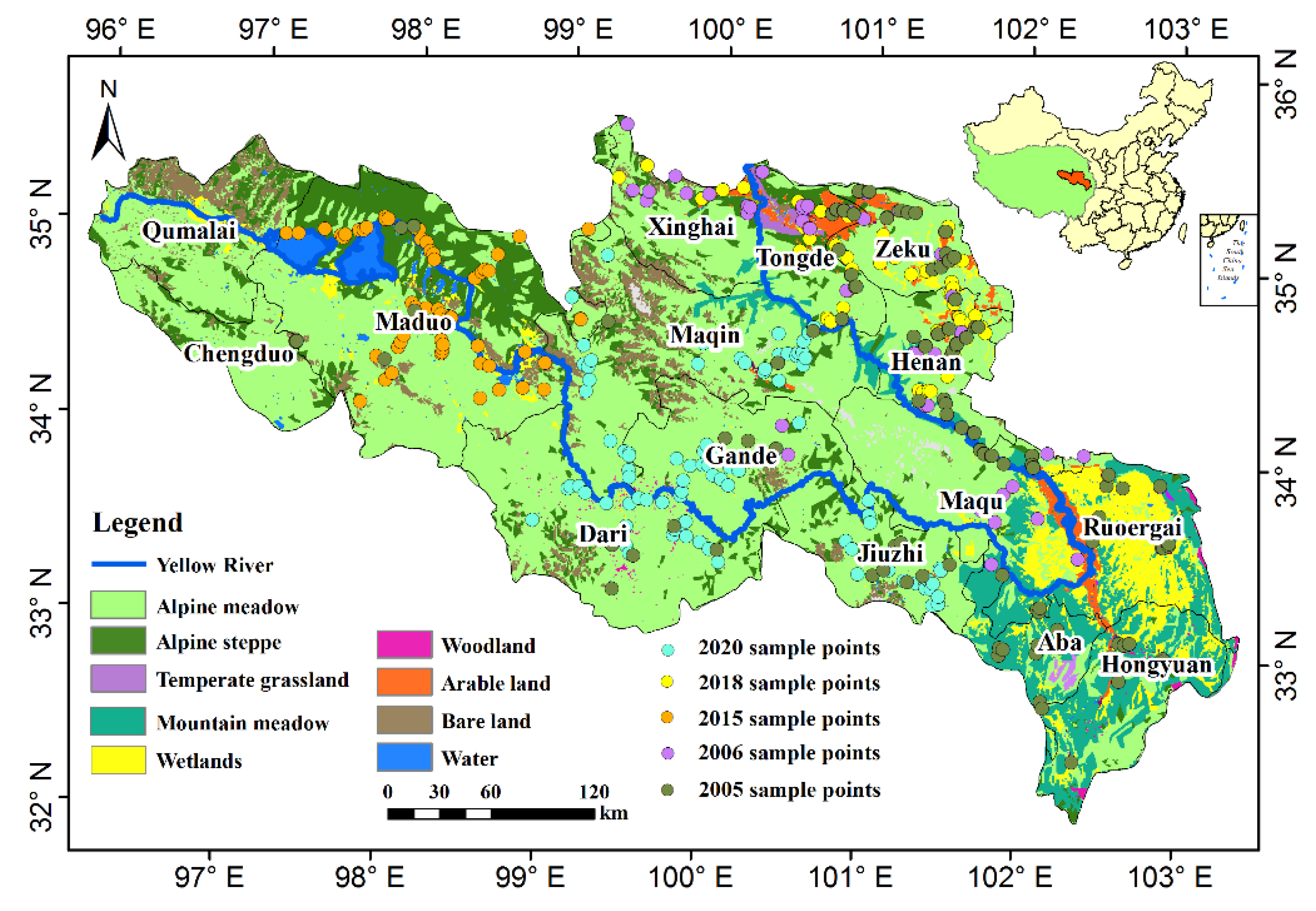
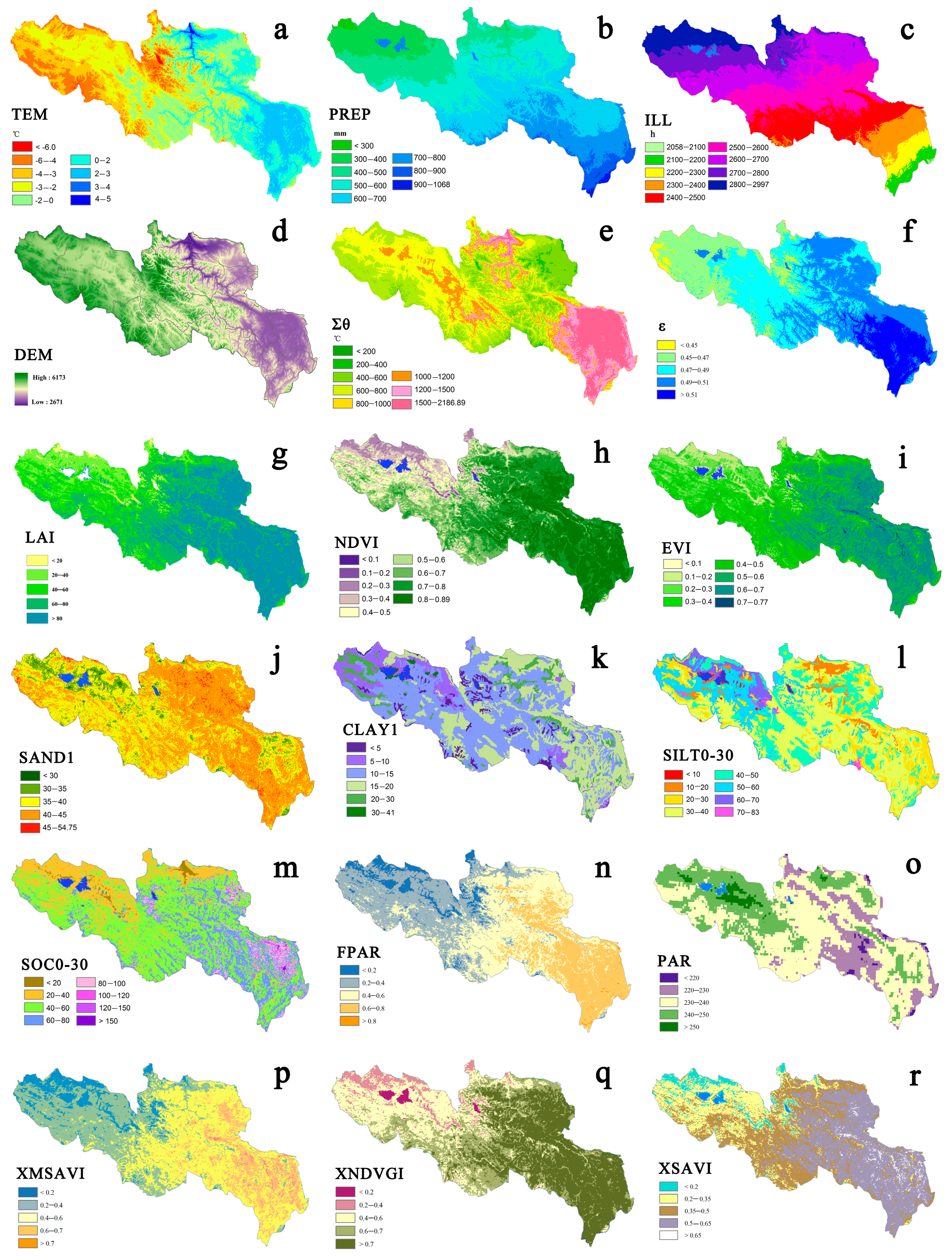
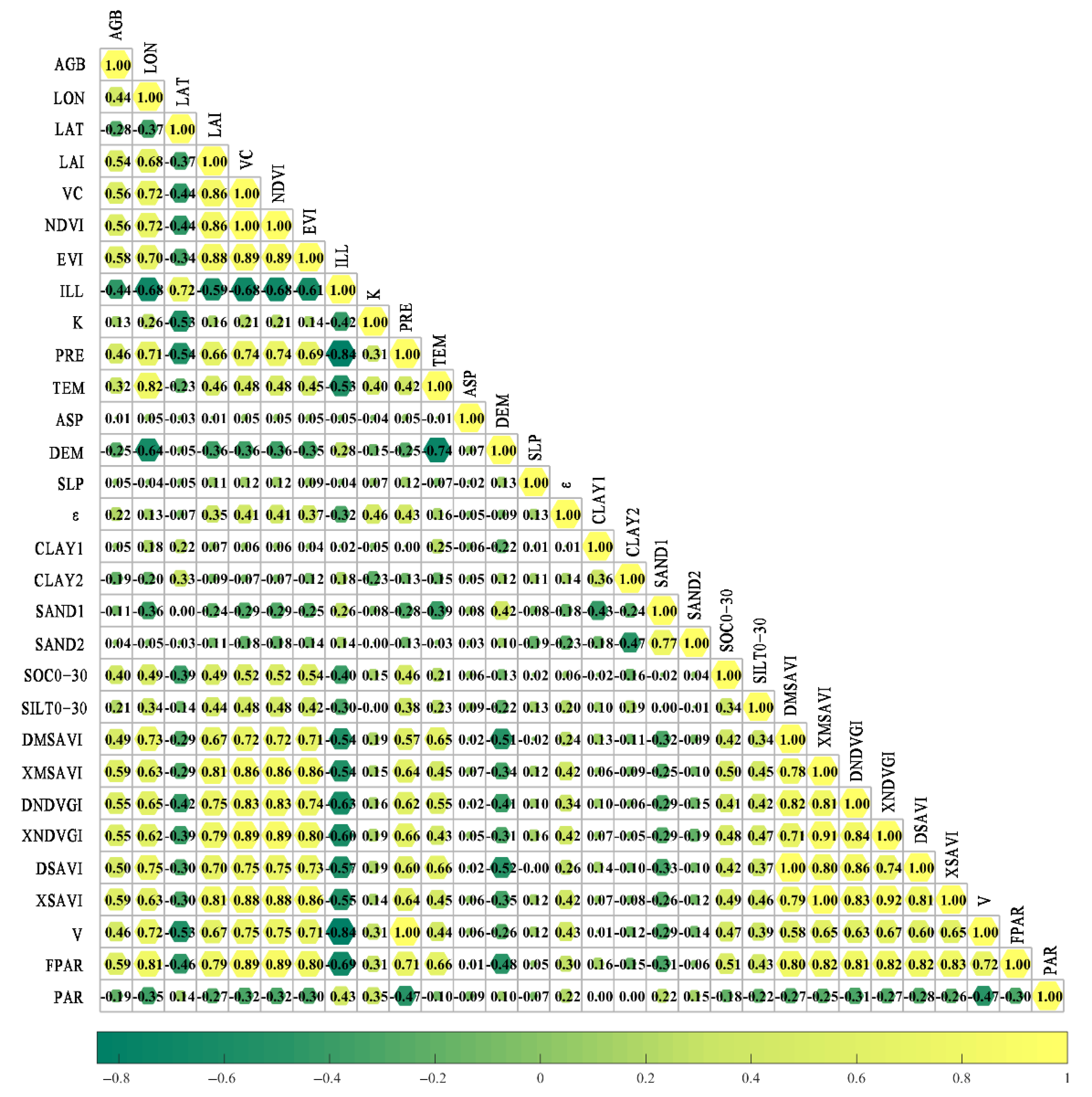
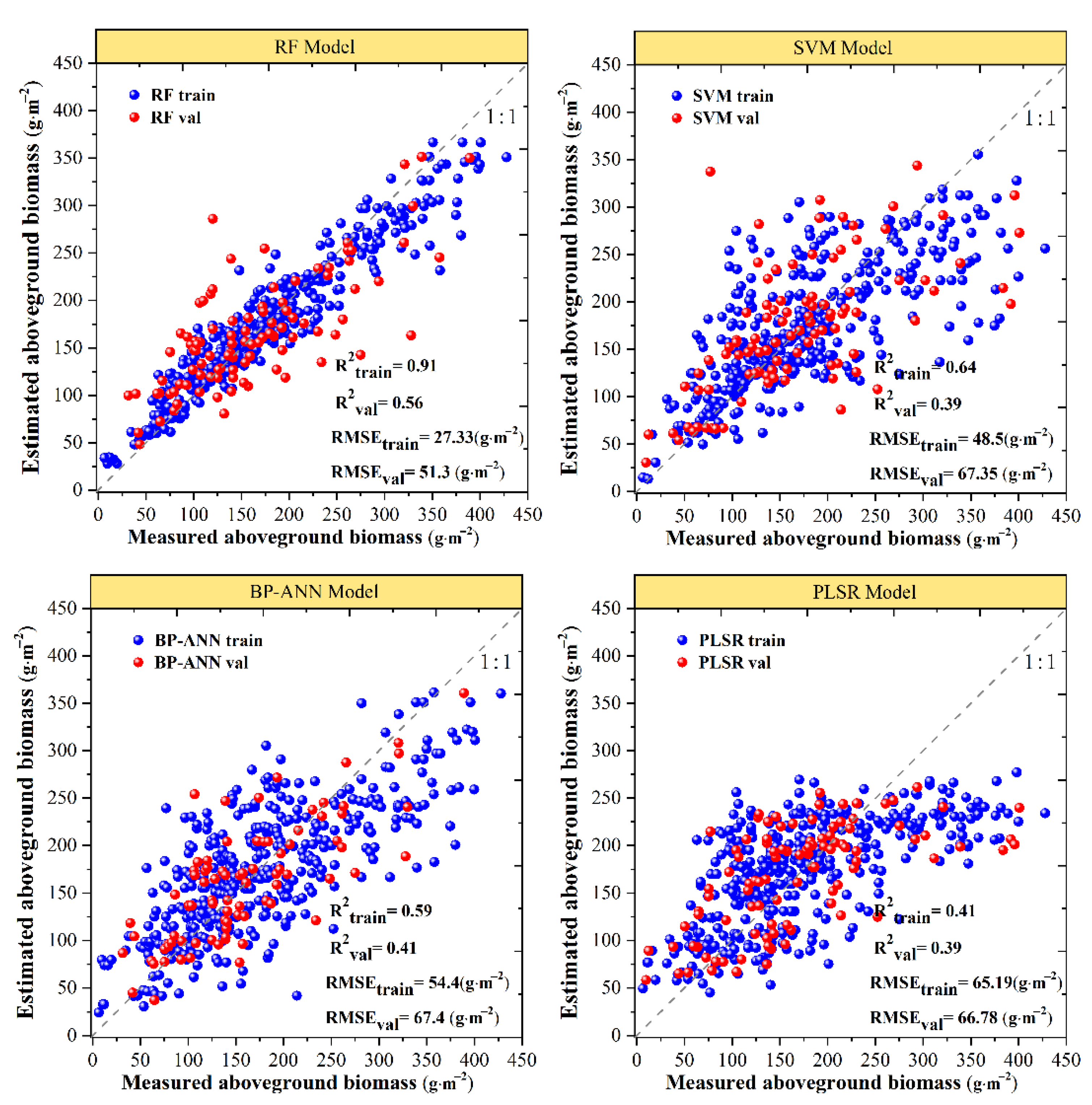
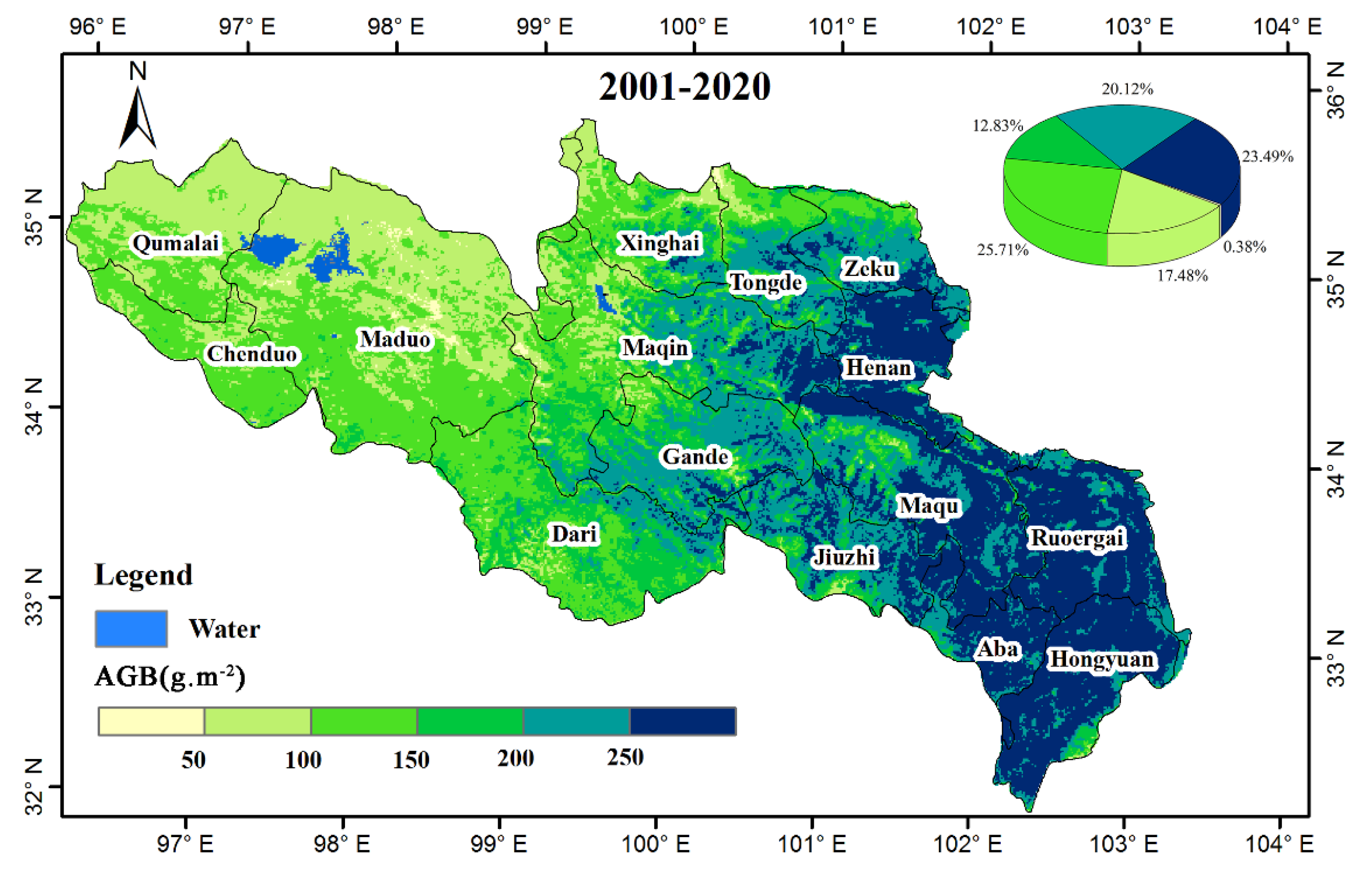
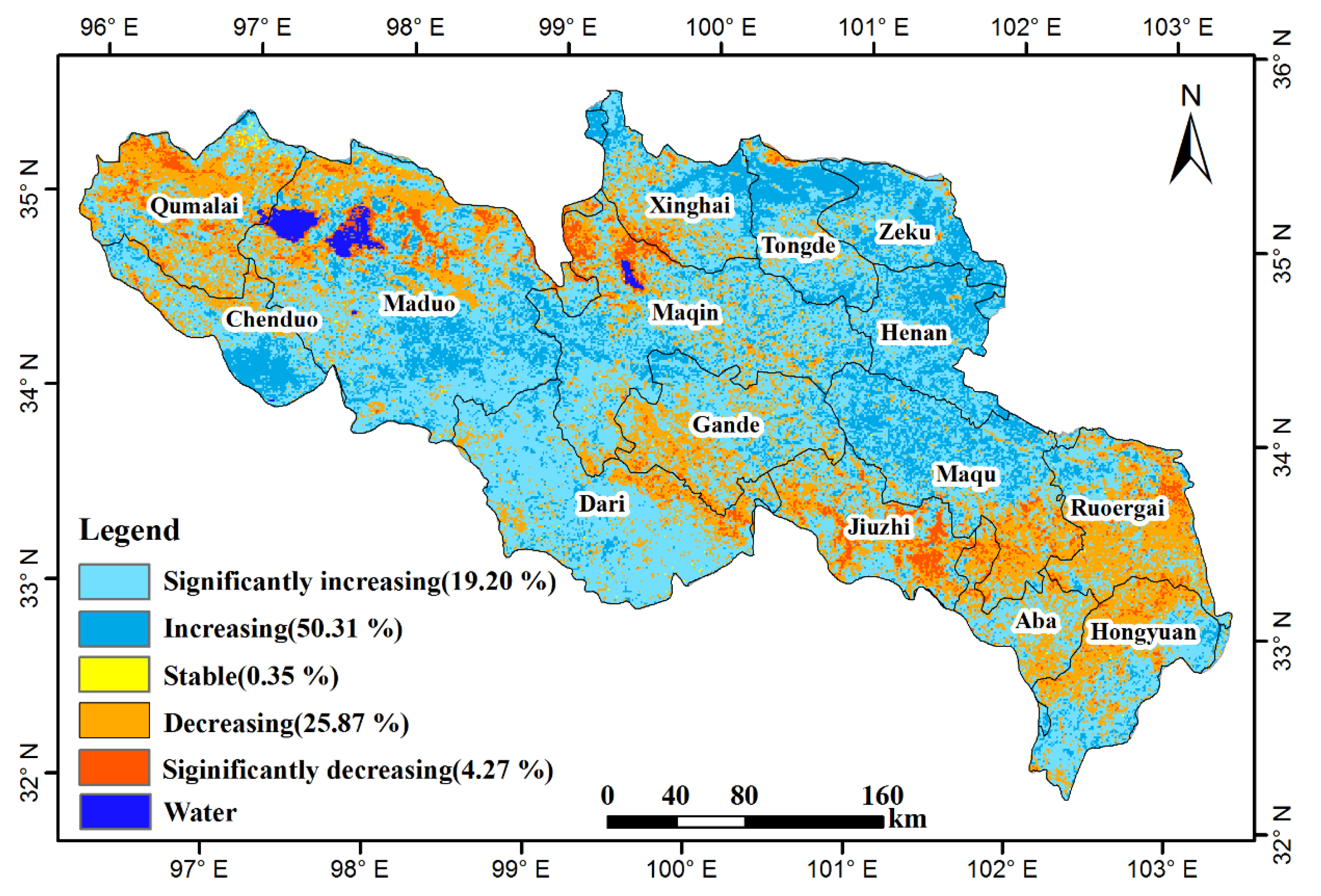
| Category | Abbreviation | Variable Interpretation | Resolution | Data Sources |
|---|---|---|---|---|
| S | CLAY1 | Clay content (0–30 cm) | 250 m | HWSD |
| S | CLAY2 | Clay content (30–100 cm) | 250 m | HWSD |
| S | SAND1 | Sand content (0–30 cm) | 250 m | HWSD |
| S | SAND2 | Sand content (30–100 cm) | 250 m | HWSD |
| S | SILT0-30 | Silt content (0–30 cm) | 250 m | HWSD |
| S | SOC0-30 | Soil organic carbon (0–30 cm) | 250 m | HWSD |
| A | PREP | Annual temperature (2001–2020) | 1000 m | Meteorological Station |
| A | TEM | Annual precipitation (2001–2020) | 1000 m | Meteorological Station |
| A | K | Humidity (2001–2020) | 1000 m | Meteorological Station |
| A | Σθ | ≥0 °C Annual cumulative temperature (2001–2020) | 1000 m | Meteorological Station |
| A | V | Actual evapotranspiration (2001–2020) | 1000 m | Meteorological Station |
| A | ILL | Illumination time (2001–2020) | 1000 m | Meteorological Station |
| T | DEM | Elevation | 30 m | SRTM |
| T | SLP | Slope | 30 m | ArcGIS Calculated |
| T | ASP | Aspect | 30 m | ArcGIS Calculated |
| T | LON | Longitude | 30 m | ArcGIS Calculated |
| T | LAT | Latitude | 30 m | ArcGIS Calculated |
| B | EVI | Enhanced vegetation index (2001–2020) | 1000 m | MOD13A2 |
| B | NDVI | Normalized difference vegetation index (2001–2020) | 1000 m | MOD13Q1 |
| B | VC | Vegetation cover (2001–2020) | 1000 m | Dimidiate Pixel Model |
| B | LAI | Leaf area index (2001–2020) | 1000 m | MOD15A2 |
| B | DMSAVI | Winter modified soil adjusted vegetation index (2001–2020) | 1000 m | MOD09A1 Band Calculated |
| B | XMSAVI | Summer modified soil adjusted vegetation index (2001–2020) | 1000 m | MOD09A1 Band Calculated |
| B | DNDVGI | Winter normalized difference vegetation green index (2001–2020) | 1000 m | MOD09A1 Band Calculated |
| B | XNDVGI | Summer normalized difference vegetation green index (2001–2020) | 1000 m | MOD09A1 Band Calculated |
| B | DSAVI | Winter soil adjusted vegetation green index (2001–2020) | 1000 m | MOD09A1 Band Calculated |
| B | XSAVI | Summer soil adjusted vegetation green index (2001–2020) | 1000 m | MOD09A1 Band Calculated |
| B | PAR | Photosynthetically active radiation (2001–2020) | 1000 m | BESS PAR |
| B | FPAR | Fraction of photosynthetically active radiation (2001–2020) | 1000 m | CASA |
| B | ε | Actual light use efficiency (2001–2020) | 1000 m | CASA |
| SENslope | Z | Trend |
|---|---|---|
| >0.001 | >1.96 | Significantly incresaing |
| >0.001 | −1.96–1.96 | Incresaing |
| −0.001–0.001 | −1.96–1.96 | Stable |
| <−0.001 | −1.96–1.96 | Decreasing |
| <−0.001 | <−1.96 | Significantly decreasing |
| County | Min | Max | Average | Standard Deviation |
|---|---|---|---|---|
| Xinghai | 44.00 | 233.92 | 104.37 | 46.00 |
| Maduo | 6.50 | 252.44 | 102.02 | 53.62 |
| Tongde | 34.47 | 264.44 | 119.22 | 68.06 |
| Zeku | 96.66 | 321.36 | 163.87 | 50.79 |
| Maqin | 11.00 | 374.92 | 167.17 | 78.29 |
| Henan | 143.88 | 400.79 | 265.14 | 64.36 |
| Gande | 100.34 | 210.64 | 146.33 | 37.45 |
| Maqu | 83.77 | 328.30 | 164.48 | 63.13 |
| Dari | 77.96 | 220.00 | 151.21 | 35.77 |
| Ruoergai | 63.00 | 357.50 | 191.19 | 86.98 |
| Jiuzhi | 74.92 | 380.20 | 188.08 | 88.15 |
| Aba | 86.40 | 253.60 | 164.12 | 39.32 |
| Hongyuan | 104.01 | 428.02 | 292.56 | 101.10 |
| Total | 6.50 | 428.02 | 171.39 | 84.89 |
| County | Obviously Increase | Slightly Increase | Stable | Slightly Increasing | Obviously Decrease |
|---|---|---|---|---|---|
| Xinghai | 24.60% | 50.13% | 0.36% | 21.57% | 3.34% |
| Qumalai | 4.66% | 35.07% | 1.48% | 50.11% | 8.69% |
| Maduo | 21.31% | 51.25% | 0.40% | 22.42% | 4.62% |
| Tongde | 39.72% | 46.91% | 0.15% | 12.42% | 0.80% |
| Zeku | 49.08% | 45.35% | 0.09% | 5.27% | 0.21% |
| Maqin | 18.65% | 56.58% | 0.24% | 19.84% | 4.68% |
| Chengduo | 28.39% | 50.11% | 0.52% | 19.72% | 1.26% |
| Henan | 49.12% | 48.53% | 0.02% | 2.30% | 0.04% |
| Gande | 11.49% | 53.56% | 0.19% | 32.77% | 1.98% |
| Maqu | 30.95% | 45.11% | 0.08% | 20.52% | 3.34% |
| Dari | 7.76% | 74.06% | 0.28% | 16.07% | 1.83% |
| Ruoergai | 6.59% | 33.74% | 0.46% | 52.50% | 6.71% |
| Jiuzhi | 6.00% | 42.63% | 0.08% | 36.92% | 14.36% |
| Aba | 3.66% | 48.27% | 0.40% | 43.43% | 4.24% |
| Hongyuan | 9.02% | 47.18% | 0.24% | 38.76% | 4.80% |
| Index | Model | Formula | R2 |
|---|---|---|---|
| NDVI | Linear | y = 0.0011x + 0.5294 | 0.313 |
| Exponential | y = 0.5031e0.0018x | 0.2758 | |
| Power | y = 0.1375x0.3213 | 0.4041 | |
| Logarithmic | y = 0.1788ln(x) − 0.1848 | 0.4313 | |
| Quadratic | y = −6 × 10−6x2 + 0.0035x + 0.3278 | 0.4327 | |
| Cubic | y = 3 × 10−8x3 − 2 × 10−5x2 + 0.0063x + 0.2023 | 0.4564 | |
| EVI | Linear | y = 9.9831x + 3434.5 | 0.3307 |
| Exponential | y = 3247.5e0.0024x | 0.2885 | |
| Power | y = 706.02x0.3859 | 0.3841 | |
| Logarithmic | y = 1567.1ln(x) − 2692.5 | 0.3885 | |
| Quadratic | y = −0.0456x2 + 28.372x + 1949.9 | 0.4068 | |
| Cubic | y = 7 × 10−5x3 − 0.0867x2 + 35.423x + 1625.9 | 0.4087 | |
| XMSAVI | Linear | y = 0.001x + 0.3281 | 0.3478 |
| Exponential | y = 0.3174e0.0023x | 0.3077 | |
| Power | y = 0.0684x0.3871 | 0.3983 | |
| Logarithmic | y = 0.1562ln(x) − 0.2813 | 0.4023 | |
| Quadratic | y = −4 × 10−6x2 + 0.0027x + 0.1944 | 0.4121 | |
| Cubic | y = 5 × 10−9x3 −7 × 10−6 x2 + 0.0032x + 0.1696 | 0.4133 | |
| XNDVGI | Linear | y = 0.0007x + 0.5543 | 0.3001 |
| Exponential | y = 0.5448e0.0011x | 0.2809 | |
| Power | y = 0.2551x0.1891 | 0.3877 | |
| Logarithmic | y = 0.109ln(x) + 0.1213 | 0.3977 | |
| Quadratic | y = −3 × 10−6x2 + 0.002x + 0.4438 | 0.3894 | |
| Cubic | y = 10−8x3 − 10−5x2 + 0.0033x + 0.3829 | 0.4033 | |
| XSAVI | Linear | y = 0.0009x + 0.3462 | 0.3426 |
| Exponential | y = 0.3352e0.002x | 0.3073 | |
| Power | y = 0.0875 × 0.3376 | 0.402 | |
| Logarithmic | y = 0.1356ln(x) − 0.1852 | 0.4089 | |
| Quadratic | y = −4 × 10−6x2 + 0.0024x + 0.2251 | 0.4138 | |
| Cubic | y = 7 × 10−9x3 − 8 × 10−6x2 + 0.0031x + 0.1912 | 0.4166 |
Publisher’s Note: MDPI stays neutral with regard to jurisdictional claims in published maps and institutional affiliations. |
© 2021 by the authors. Licensee MDPI, Basel, Switzerland. This article is an open access article distributed under the terms and conditions of the Creative Commons Attribution (CC BY) license (https://creativecommons.org/licenses/by/4.0/).
Share and Cite
Tang, R.; Zhao, Y.; Lin, H. Spatio-Temporal Variation Characteristics of Aboveground Biomass in the Headwater of the Yellow River Based on Machine Learning. Remote Sens. 2021, 13, 3404. https://doi.org/10.3390/rs13173404
Tang R, Zhao Y, Lin H. Spatio-Temporal Variation Characteristics of Aboveground Biomass in the Headwater of the Yellow River Based on Machine Learning. Remote Sensing. 2021; 13(17):3404. https://doi.org/10.3390/rs13173404
Chicago/Turabian StyleTang, Rong, Yuting Zhao, and Huilong Lin. 2021. "Spatio-Temporal Variation Characteristics of Aboveground Biomass in the Headwater of the Yellow River Based on Machine Learning" Remote Sensing 13, no. 17: 3404. https://doi.org/10.3390/rs13173404
APA StyleTang, R., Zhao, Y., & Lin, H. (2021). Spatio-Temporal Variation Characteristics of Aboveground Biomass in the Headwater of the Yellow River Based on Machine Learning. Remote Sensing, 13(17), 3404. https://doi.org/10.3390/rs13173404




